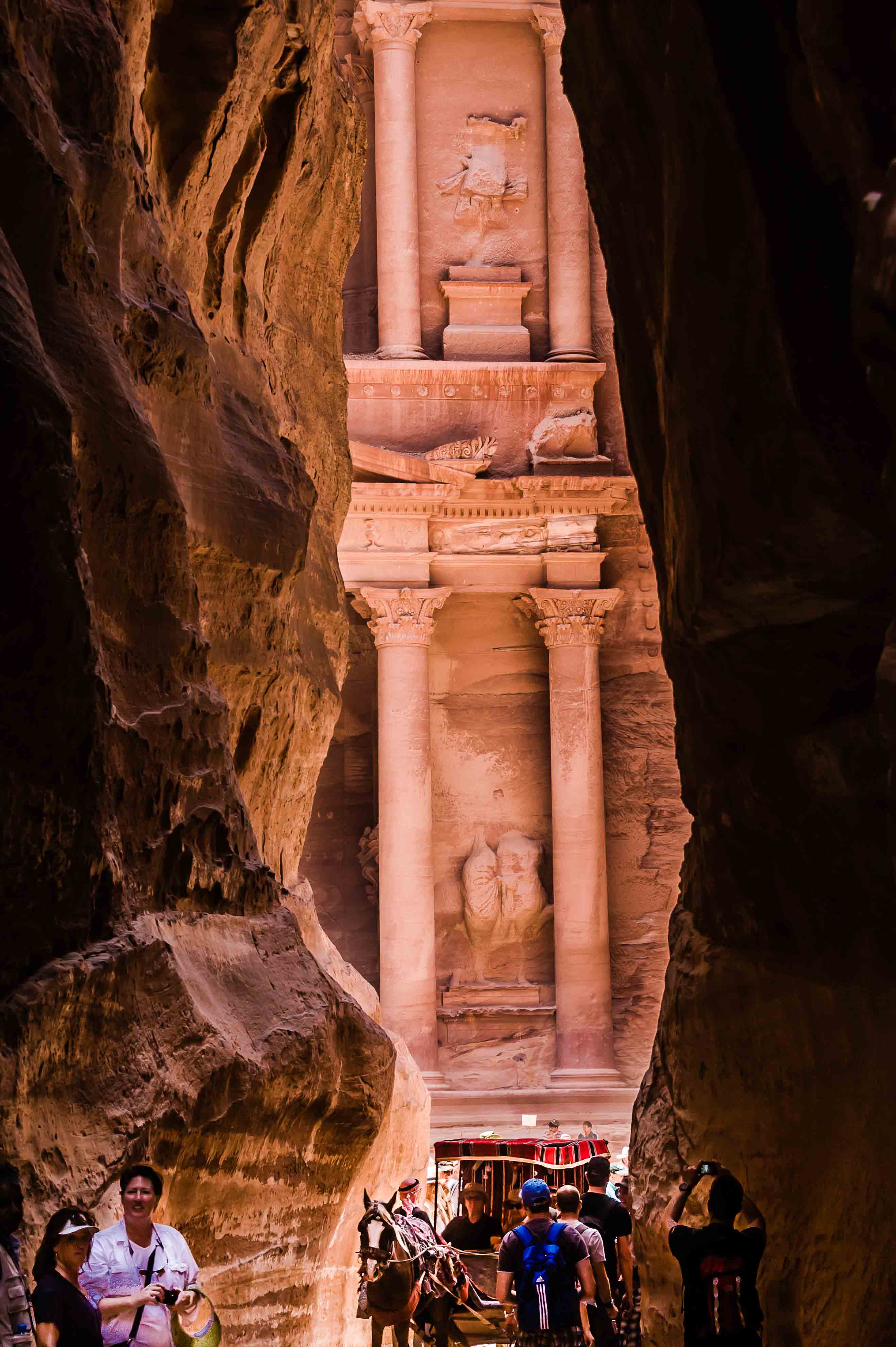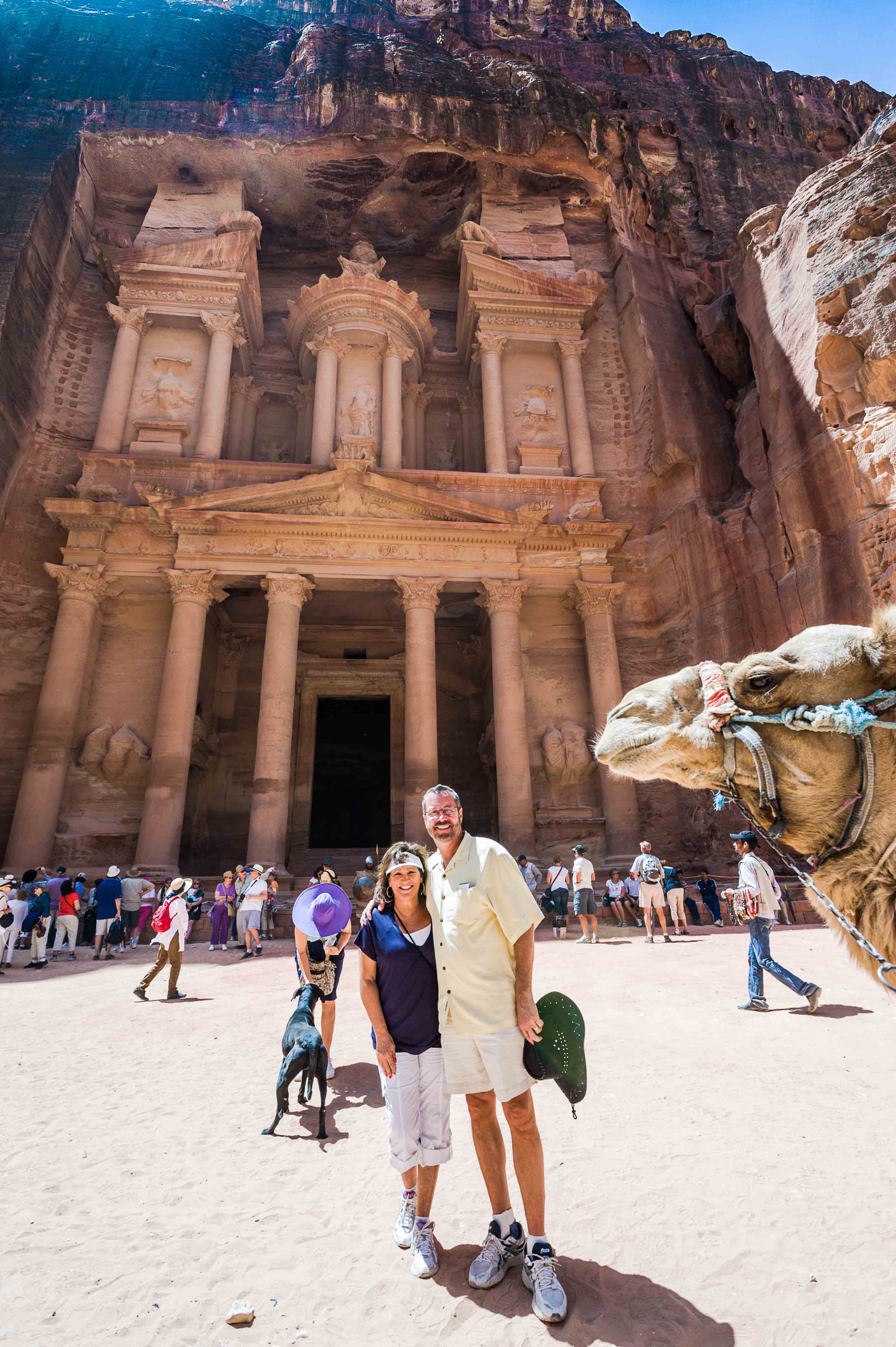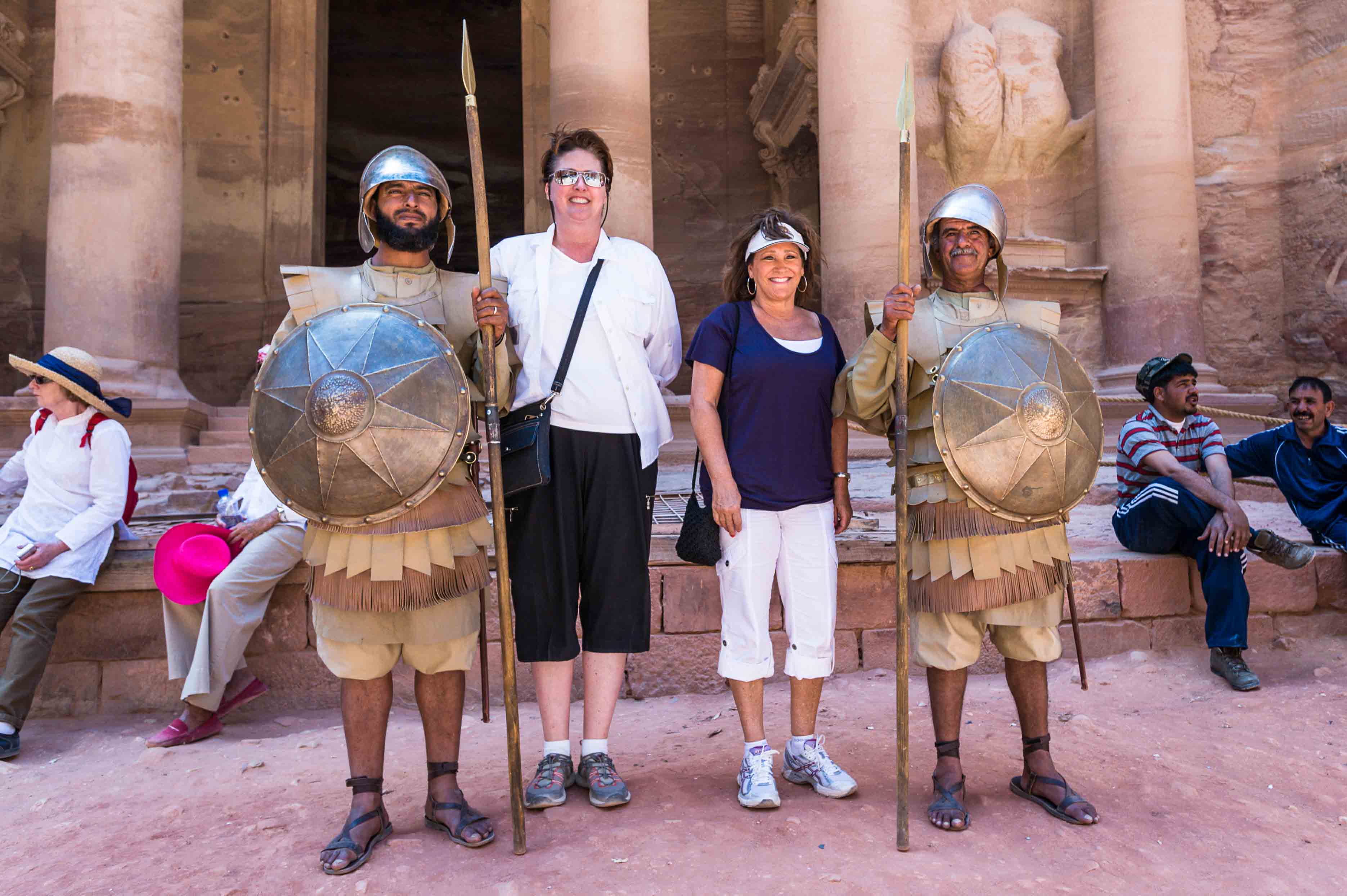Happy Easter everyone! This was one of the most amazing days we’ve had so far on this trip, and that’s saying a lot! We decided to take a private tour with our new friends Paul and Kathy to the ancient city of Petra.
We left the Port of Aqaba at 9:00 am and drove 2 hours to the city of Petra. We have a driver and guide today and even though our tour guides’ name was Jehad, Paul decided to call him John. I guess he didn’t want to call out “Jehad” which sounds very similar to “Jihad” in crowded Muslim areas! Probably a good idea.
Petra is a historical city in Jordan established around the 6th century BC as the capital city of the ancient Nabataean people. it is the primary symbol of Jordan as well as its most visited tourist attraction. It is famous for its rock-cut architecture and water conduit system.
Petra lies on the slope of Mount Hor in a basin among the mountains that form the eastern flank of Arabah (Wadi Araba), the large valley running from the Dead Sea to the Gulf of Aqaba. Petra has been a UNESCO World Heritage Site since 1985. We drove bout 1.5 hours through desert that looked somewhat similar to some of the desert areas northeast of Los Angeles seeing shepherds guiding their flocks, stopping at a store to look for a hat for Paul (he tends to lose them from time to time) and stopping a couple times just to admire the scenery and take some pictures. Finally we saw the entrance to Petra far below as we approached the reasonably populated city just outside the entrance gate.
This part of Jordan used to be a gateway for businessmen doing trade. There is an area now called “Little Petra” just up the road (we would go there later in the day) that similarly was a passageway through sandstone. Little Petra, however, was the place where business was done. “Big Petra”, on the other hand, was a spiritually oriented place and a sacred burial place, with tombs built into the tall sandstone walls. The Nabataeans created this “Siq” where an ancient river had carved through the sandstone. The Nabataeans diverted the seasonal water that still flowed here with man-made dams to create a protected entrance to the area and then carved tombs from massive sandstone rock faces; it’s truly an awe-inspiring achievement and the detail is incredible.
After buying our entrance tickets, we walked by a Hyatt hotel which is partly built into the sandstone, walked by the typical shops selling local wares and entered the “park”. Here you could catch a ride on a horse-drawn cart for the mile-long ride over dirt and rock-paved narrow roads through tall sandstone “cliffs”. We decided to walk in on the fairly busy road getting a tour along the way from John. The video below shows some carts going by on our walk in and then the ride we took on the way out.
When we got to the end of the walk through the high-walled chasm, called The Siq, we saw the Treasury. This is the first and most incredible architectural component that you see at Petra. It is breathtaking…absolutely incredible.
Once inside, we walked to an area where you can rent donkeys or camels to ride through the inner part of Petra. We opted to take the donkey ride and had no idea what we had in store for us! The video below shows what the camels looked and sounded like.
We all had Petra on our bucket list, but Paul also had on his to go to the Monastery at the top of 1,000 stairs, high up on the mountain. The donkeys seemed a good and fast way to get there.
The only downside of riding the donkeys to get to the Monastery is that you had to ride a donkey! We’ve never ridden donkeys before and it is different than riding a horse…you can’t really “steer” a donkey (at least not these donkeys). And, my donkey liked to be out front, so our guide (who was only 11 years old) kept yelling “Out of control! Out of control!” I assumed he was speaking about the donkey and not me!
Soon after getting on our donkeys we passed by Judy and Franco riding Camels in the other direction. I am not sure if Camels are easier to ride than donkeys but at least the donkeys are closer to the ground if you should happen to fall off!
As we continued through town, people needed to jump aside as we came trotting (sort of) through the crowds. Our guide kept hitting my donkey on the rear to get him to move faster and all I could do was hang on. Then, when we got to the stairs, the donkeys kept going right on up and we had to learn to not only hang on tight, but also lean as far forward as we could in order to get our center of gravity closer to the donkey’s head. Pretty crazy especially when we got to areas where it was really steep, there were people and other donkeys sharing the same steps and sheer cliff drop offs!
We finally made it to the top of the mountain and got down off of our mounts. That is when I learned that another guide had come down the stairs with 2 donkeys and basically squeezed Dale’s donkey off the path. His donkey ended up sliding down a 6-foot drop off and Dale luckily hung on for the ride!
We had a 15-minute hike to get up to the Monastery and it was well worth the effort. It’s another amazing example of the skill and persistence of the Nabataean people.
After taking some great pictures of the monastery, where both Dale and Paul scaled the wall to get up into the structure, Dale found a guy standing on his head and took a picture of him as well. Pretty cool.
Now, riding donkeys up stairs is one thing…but riding them down stairs is even crazier! After only a few minutes of riding, two donkeys coming down the stairs pushed Dale’s donkey (again) off the narrower steps onto some steeper ones. When this happened the saddle slid to one side along with Dale! His foot was caught in the stirrup, so he didn’t fall off all the way. Luckily he only broke his camera lens hood and didn’t hurt himself.
After that excitement Kathy, Dale and I decided to walk down the stairs and Paul remained on his donkey. He later told us there were at least two times when he was holding his breathe on the way down the stairs hoping he’d make it!
Back at the base we found our guide and decided to take horse-drawn carriages back through The Siq to get out to where our mini-van was waiting. The Siq has some original areas that are covered with rugged stones making for a bumpy ride! It was a LOT faster than walking and gave us some extra time in the small town area to look around.
Paul, being the pre-eminent shopper that he is, immediately went to investigate the shops while Kathy and I sought out cold beverages and found a cool bar called “the cave bar”. While Dale went to tell Paul where we were, Kathy and I relaxed and relived our incredible Petra adventure.
While Paul shopped, the rest of us went to visit “Little Petra”. It is believed Little Petra was an important suburb of Petra, the entry and exit point for the trade routes to the north and northwest. Here the caravans from the Negev, Gaza, Jerusalem, Egypt and the Mediterranean coast arrived, had a rest and engaged in trade. Like in Petra buildings had been carved into the sandstone, used as residences, storages and tombs, with water channels and cisterns. In one of the buildings you can find the remains of painted frescos with birds, grapes and flowers, dating from the 1st century AD.
After visiting Little Petra we drove back to town to pick up Paul and the ride back to the ship. We were all happy and exhausted after our incredible Easter day in Petra. It turns out riding the donkey was probably more work than if we’d actually just walked up on our own. Hindsight being what it is, we probably shouldn’t have taken the donkeys up the mountain, but we are glad that we did!
Here is the Top Picture Gallery for Petra:
Click here for the detailed Petra Picture Gallery.



.jpg)



Trip Summary » Travel with Dale & Margaret - […] Petra (Aqaba), Jordan […]